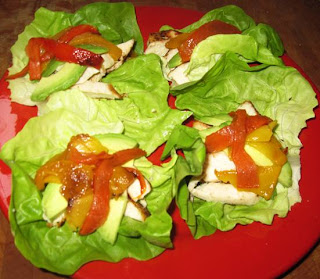
I had a version of this Cobb salad at The Interstate Kitchen and Bar, which is just a block away from our gym in Denver. Their salad contained bacon, but since Mike and I don't eat the pig, I made a different rendition that has become my favorite go-to salad. My favorite part is the soft fried egg. When you eat the egg, the yolk runs over the salad and makes a rich and creamy dressing.
1 head butter lettuce
marinated boneless skinless chicken thighs (recipe below)
1 orange, cut into segments
1 avocado
2 eggs (one for each salad)
2oz toasted chopped walnuts
Marinade:
1/4 cup orange juice
1/8 cup olive oil
1 tbsp each salt and chili powder
1/2 tbsp black pepper
2 tbsp minced chives
Mix all marinade ingredients in a large bowl and add the chicken. Marinade at least 8 hours. Grill chicken thighs until slightly charred. Let sit 10 minutes, then dice.
To assemble the salad, tear butter lettuce leaves and arrange on a large plate. Add slices of the segmented orange, avocado, walnuts and as much chicken as you want. Top with a fried egg.
marinated boneless skinless chicken thighs (recipe below)
1 orange, cut into segments
1 avocado
2 eggs (one for each salad)
2oz toasted chopped walnuts
Marinade:
1/4 cup orange juice
1/8 cup olive oil
1 tbsp each salt and chili powder
1/2 tbsp black pepper
2 tbsp minced chives
Mix all marinade ingredients in a large bowl and add the chicken. Marinade at least 8 hours. Grill chicken thighs until slightly charred. Let sit 10 minutes, then dice.
To assemble the salad, tear butter lettuce leaves and arrange on a large plate. Add slices of the segmented orange, avocado, walnuts and as much chicken as you want. Top with a fried egg.

























